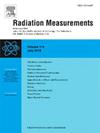用EGSnrc蒙特卡罗方法模拟诊断放射学剂量学中CaSO4:Dy的x射线热释光响应
IF 2.2
3区 物理与天体物理
Q2 NUCLEAR SCIENCE & TECHNOLOGY
引用次数: 0
摘要
本研究采用EGSnrc蒙特卡罗(MC)代码对CaSO4:Dy热释光剂量计(TLD 900)的能量响应进行了评价。研究了粉末形式的CaSO4:Dy (0.15 wt% Dy)剂量计,以评估其在室温下对PMMA模体的x射线和伽马辐射的能量响应。利用模拟结果和物理测量结果,开发了光子能量响应、校正因子、元素C1和C2的响应、r12比以及以Hp(10)表示的剂量算法。将能量和剂量算法的估计与实验数据进行比较,以验证其准确性并识别潜在的差异。利用来自诊断x射线的光子能量,从不同滤光器下元素的r12比开发了一种精度为20%的Hp(10)估计剂量算法。此外,模拟结果与物理测量结果吻合较好,验证了MC模拟方法适用于描述不同辐照条件下具有复杂几何形状的粒子与材料的相互作用。本文章由计算机程序翻译,如有差异,请以英文原文为准。
Modelling the X-ray thermoluminescent response of CaSO4:Dy for dosimetry in diagnostic radiology by EGSnrc Monte Carlo method
In this study, the EGSnrc Monte Carlo (MC) code was used to evaluate the energy response of CaSO4:Dy thermoluminescence dosimeters (TLD 900). CaSO4:Dy (0.15 wt% Dy) dosimeters in powder form were studied to evaluate their energy response to X-ray and gamma radiations at room temperature on the PMMA phantom. The photon energy response, the correction factor, the response of elements C1 and C2, the r12 ratio, and the dose algorithm in terms (10) were developed, leveraging both simulation results and physical measurements. The energy and dose algorithm’s estimations were compared against experimental data to validate its accuracy and identify potential discrepancies. A dose algorithm for (10) estimation within an accuracy of 20% was developed from the r12 ratio of elements under different filters using photon energy ranging from diagnostic X-ray. In addition, the simulation results agree well with the physical measurements, validating that the MC simulation method is well-suited for describing the interactions of particles and materials with complex geometries under different irradiation conditions.
求助全文
通过发布文献求助,成功后即可免费获取论文全文。
去求助
来源期刊

Radiation Measurements
工程技术-核科学技术
CiteScore
4.10
自引率
20.00%
发文量
116
审稿时长
48 days
期刊介绍:
The journal seeks to publish papers that present advances in the following areas: spontaneous and stimulated luminescence (including scintillating materials, thermoluminescence, and optically stimulated luminescence); electron spin resonance of natural and synthetic materials; the physics, design and performance of radiation measurements (including computational modelling such as electronic transport simulations); the novel basic aspects of radiation measurement in medical physics. Studies of energy-transfer phenomena, track physics and microdosimetry are also of interest to the journal.
Applications relevant to the journal, particularly where they present novel detection techniques, novel analytical approaches or novel materials, include: personal dosimetry (including dosimetric quantities, active/electronic and passive monitoring techniques for photon, neutron and charged-particle exposures); environmental dosimetry (including methodological advances and predictive models related to radon, but generally excluding local survey results of radon where the main aim is to establish the radiation risk to populations); cosmic and high-energy radiation measurements (including dosimetry, space radiation effects, and single event upsets); dosimetry-based archaeological and Quaternary dating; dosimetry-based approaches to thermochronometry; accident and retrospective dosimetry (including activation detectors), and dosimetry and measurements related to medical applications.
 求助内容:
求助内容: 应助结果提醒方式:
应助结果提醒方式:


